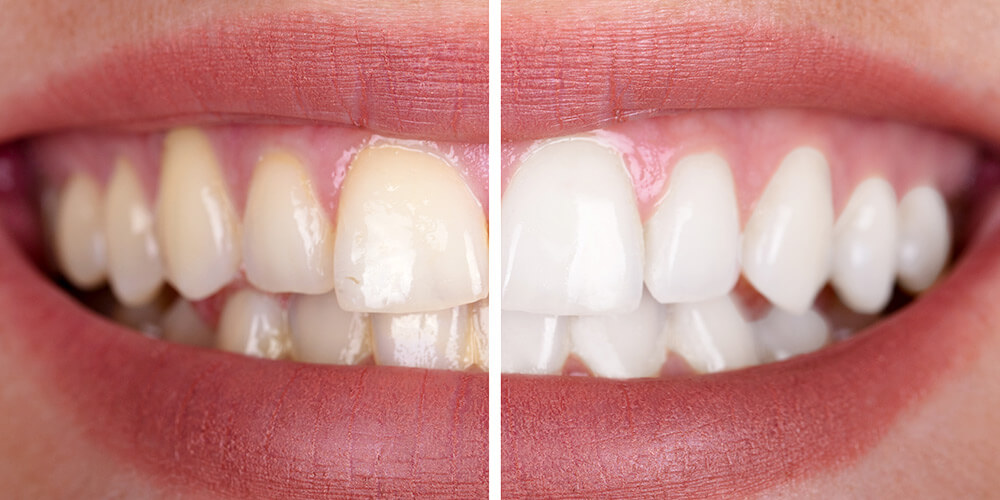Caries – a hole in the tooth
Caries is one of the most common diseases to affect people around the world. The proverbial cavity in the tooth is also known as tooth decay. The term caries is Latin and means decay. From a medical point of view, however, this term is not quite correct since the tooth does not rot.
What is caries? Caries refers to the destruction of enamel caused by the metabolic products of bacteria. Specifically, tooth decay occurs when bacteria, fungi, viruses and protozoa, which occur naturally in our oral cavity, take up sugar from food and convert it into acid. These acids attack the enamel, weaken it and leave the tooth surface porous.
Our saliva is usually able to repair minor damage to the tooth ("remineralise"). Frequent sweet treats during the day and poor oral hygiene, however, lead to a gradual degradation of the tooth enamel, which can result in the formation of a recess or hole under the tooth surface.
This article provides information on how to recognise caries as well as the signs of this tooth disease. Read on to find out about the most frequent types of caries, what you can do specifically and how caries is treated. The article also includes useful tips for effectively preventing caries.
Detecting caries
In the early stages caries is not always immediately visible. After all, it often starts on the chewing surfaces of the molars, between the teeth, on exposed roots and around fillings. If plaque is not consistently removed as part of regular oral care, then the likelihood of caries forming on the teeth increases.
Only your dentist can tell from an x-ray whether caries is in an early stage and how far it has progressed. Caries is frequently already well advanced deep inside the tooth, but this is not visible from the outside.
However, you can recognise some of the symptoms of caries yourself. Possible signs of caries are:
- Toothache: Whether you notice carious teeth through pain depends on where the caries is located. A cavity in the enamel may not necessarily be painful. It only becomes painful when the decay reaches the soft middle layer of a tooth, the so-called pulp with nerves and blood vessels.
- Teeth that are sensitive to sweet, hot or cold food or drinks
- Pain when chewing
Types of caries
Not all types of caries are the same. Tooth decay is a gradual process as acids constantly attack the tooth surface. It takes some time before the proverbial "cavity in the tooth" becomes visible to the naked eye. This is why caries is divided into various development stages depending on severity.
- First stage - white spots (initial caries): Formation of chalky-white areas on the surface of the teeth due to the accumulation of plaque and the resulting acid-related mineral loss of the teeth Calcium and phosphate are washed out of the tooth. This process is referred to as demineralisation. In this stage, the caries can often still be reversed.
- Second stage - caries in the enamel: The enamel under the surface of the tooth begins to break. In this stage, the natural remineralisation process cannot restore the enamel and the necessary minerals resulting in damage within the tooth. In the course of this destruction there is a risk of the tooth surface becoming fractured, which is irreversible. If one of your teeth breaks, you must go to your dentist straight away.
- Third stage - caries in dentine (dentine caries): If treatment is not provided or if the caries has not been noticed for a long time, bacteria and acids can further dissolve the enamel and the damage can progress to the dentine. The dentine lies between the enamel and the tooth nerve. If the damage extends this far, the pain in the affected tooth worsens. The tooth must be drilled. The only solution to repair the tooth now is a filling.
After the cavity has been filled and repaired by the dentist, in the course of time, caries can form again on the edges of fillings and crowns (secondary caries). This is due to the fact that in these areas of fillings plaque can build up more easily and this is harder to remove by cleaning and that plaque bacteria in the gaps between the tooth and the filling material usually remain unhindered and cause damage. - Fourth stage - the dental nerve is attacked: The tooth nerve is inside the tooth. It is surrounded by blood vessels and is referred to as the "pulp". The pulp is made up of living tissue and cells. Some specialised cells are able to regenerate dentine. If the pulp is infected with bacteria, the "typical" inflammation process occurs. Pus frequently forms and the body cells try to fight the infection. This can lead to persistent pain. Root canal treatment (removal of the tooth nerve) is frequently necessary.
- Fifth stages: Formation of an abscess: If the caries goes untreated, the inflammation can travel from the pulp to the bone via nerve paths in the tooth root. This results in bone resorption and abscesses in soft tissue. Complex orthodontic treatments are now often necessary.
What can be done to treat caries?
Visible caries is not just a cosmetic problem, it can also be painful and unpleasant. If it goes untreated, a surgical intervention is required in the worst case scenario. If you have the impression that you have caries, the following measures are recommended:
- Arrange an appointment to see your dentist as soon as possible.
- Continue to clean your teeth properly.
- Even if it is painful when you floss and clean, you should not leave out the sensitive areas.
- Use a toothbrush with soft bristles, soft floss, mouthwash and warm water
- Discuss how to best proceed together with your dentist.
Causes of caries
Four central factors are required for caries formation:
- Food and drink: Every time you eat something, the acids from food can attack your teeth. The food remains and acids are washed away with the help of saliva as a means of defence. Saliva not only works to weaken and neutralise acids, it also contains minerals (calcium and phosphate) that "repair" the demineralised areas of the tooth that have been attacked by the acids (remineralisation).
- Bacteria contained in plaque: We have many microorganisms in our oral cavity. Some of these small living organisms are able to adhere particularly well to our teeth. This coating, also known as the biofilm, consists of bacteria, small fungi, viruses and protozoa. Some types, such as Streptococcus mutans and Lactobacillus spp. love sugary foodstuffs. They need these to recover energy to turn sugar into lactic acid.
Lactic acid attacks the tooth surfaces and demineralises or "decalcifies" them. This is similar to using citric acid to decalcify pots or coffee machines; the lactic acid removes minerals, mainly calcium and phosphates, from the tooth.
The initial stages of demineralisation can be reversed by the minerals in saliva. If more minerals are removed from the tooth surface over a longer period of time, the destruction continues and the enamel becomes softer. The damage to the tooth initially often goes unnoticed. The caries often spreads further into the dentine and then continues on to the tooth nerve. This carious defect manifests itself as pain when eating or drinking.
Treatment of caries
Whilst caries cannot be healed, there are treatment options. Depending on the severity of the caries, your dentist may need to drill to remove the carious part of a tooth and use a filling to restore the tooth's function.
If a tooth is in very poor condition, it may be necessary for the dentist to remove a large area of the badly damaged tooth structure and replace it with a crown. The crown is fitted to the remaining part of the tooth.
If the caries is so advanced that the nerves of a tooth are severely inflamed or dead, then root canal treatment may be necessary. For this, the nerves and tissue must be removed from the tooth. The tooth is filled with different materials and a crown is often put on the tooth.
If caries is not treated, it spreads over the entire tooth, can infect the adjacent tissue and destroy the periodontal apparatus. If the jaw is also inflamed or damaged, orthodontic treatment may proved necessary.
Tips for preventing caries
The best remedy against caries is: To not let it develop in the first place. Effective dental care and oral hygiene, remineralisation of the tooth enamel, eating habits and regular check-ups at the dentist all help to prevent caries. You will find all the tips in the overview:
Prevent caries through dental care:
- Brush your teeth at least twice a day.
- You should also use floss and/or interdental brushes to clean your teeth in order to remove the plaque between the teeth and below the gum line.
- The regular use of a tooth gel, such as KAREX gel, can additionally boost remineralisation of the enamel and aid caries prophylaxis.
- Have your teeth cleaned professionally on a regular basis and go for regular check-ups.
Protect enamel through your choice of diet:
- Opt for a balanced diet and reduce the amount of sugary foods you eat.
- Drink unsweetened beverages, e.g., water and sugar-free tea.
- Calcium is one of the most important minerals against caries. Foodstuffs such as milk, yoghurt and cheese are natural sources of calcium.
- High-fibre foods keep saliva flowing, which, in turn, creates mineral defences against caries. Ideal sources of fibre include dried fruits (e.g., dates, raisin, figs) as well as bananas, apples and oranges. Other good source are vegetables, e.g., beans, sprouts and peas as well as peanuts, almonds and bran. Important: Some of these fruits and vegetables contain a lot of acid. That's why, you should eat these together with yoghurt or quark.
- Whole grain products provide vitamin B and iron which keeps the gums healthy.
You can prevent caries by consuming only limited sugary and sticky foodstuffs and sweetened drinks between meals.
Help from the dentist:
- Go to your dentist for regular check-ups. It is recommended to go twice a year. He is able to recognise the initial stages of caries and take the necessary measures.
- Professional tooth cleaning removes stubborn plaque from all tooth surfaces and cleans the interdental spaces.
- Children and adults can have the deep areas in the molars (so-called fissures) sealed. As these are difficult to reach with a toothbrush, caries can develop more easily here. Fissure sealing prevents microorganisms from building up.
This may also be of interest to you:

Inflammation of the gums: Gingivitis or periodontitis?
More than 50% of adults suffer from gum problems. Find out more about what can help.

Tooth discolouration and tooth whitening
Tooth discolouration is essentially a cosmetic issue. Discover what methods are available to get your teeth looking white again.

Sensitive teeth – when enjoying food becomes impossible
Sensitive teeth are often caused by exposed tooth necks or defects in the dental enamel, find out more about this.









